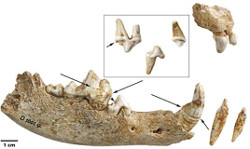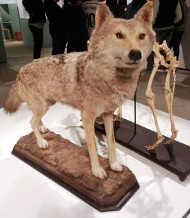|
Dog Domesticated 14,000 Years Ago: Study
February 27, 2018
Archaeologists say that they have found evidence of humans' having a pet dog 14,000 years ago. A new study of the century-old Oberkassel remains has convinced researchers that the man and the woman buried in the grave cared for the dog buried in the grave, in a way that modern humans would find familiar. Workers uncovered the rare double burial grave in a stone quarry in the Bonn, Germany, suburb in February 1914. The bones and the surrounding were covered in ochre. Along with bones of a man and a woman were bones of a dog and a handful of objects, including artwork crafted from antlers, bones, and ivory. The grave is the oldest yet discovered that contains bones of both humans and dogs. One of the people examining the bones in the new study was Luc Janssens, a veterinarian studying at Leiden University. Janssens found on the dog's teeth what appear to be signs of distemper, contracted when the dog was just 19 weeks old. Analysis of the dog's bones showed that it died at 28 weeks. Further, Janssens, who is also an archaeologist, found evidence of repeated bouts of serious illness and concluded that the dog must have been cared for, likely by the people buried with the dog. That, coupled with the dog's being buried along with two humans, was enough to convince the team of archaeologists to which Janssens belonged that they were looking at the earliest yet known instance of dog domestication by humans. The man and woman were part of a group of people living in Upper Kallsel, in the Rhine Valley. They were hunter-gatherers who lived in round tents similar to yurts. The dog has been shown to be a direct ancestor of today's canines. The remains are among the oldest humans ever found in Germany. They date to 14,000 years ago. DNA analysis of the humans' bones showed that they were related but not as closely as brother and sister. The woman was found to be 20–25; the man was found to be 35–45. Facial reconstructions show that these Paleolithic people would have looked familiar to modern viewers. Reconstruction of the dog showed it also to look very modern. The results of the latest study appear in the Journal of Archaeological Science.
|
Social Studies for Kids |
Social Studies for Kids
copyright 2002–2019
David White







